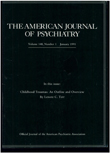Positron emission tomography of the cerebellum in autism
Abstract
On the basis of neurological evidence that autistic patients have fewer Purkinje and granule cells in the cerebellum as well as vermal cerebellar hypoplasia, the authors tested the hypothesis that autistic patients have cerebellar hypofunctioning. They used positron emission tomography of the cerebellum with 18F-labeled 2-deoxyglucose to study seven autistic patients and eight age-matched control subjects. The results showed no significant difference in mean cerebellar glucose metabolism between the two groups, but all mean glucose rates of the autistic patients were either equal to or greater than those of the control subjects. The implications of these findings are discussed.
Access content
To read the fulltext, please use one of the options below to sign in or purchase access.- Personal login
- Institutional Login
- Sign in via OpenAthens
- Register for access
-
Please login/register if you wish to pair your device and check access availability.
Not a subscriber?
PsychiatryOnline subscription options offer access to the DSM-5 library, books, journals, CME, and patient resources. This all-in-one virtual library provides psychiatrists and mental health professionals with key resources for diagnosis, treatment, research, and professional development.
Need more help? PsychiatryOnline Customer Service may be reached by emailing [email protected] or by calling 800-368-5777 (in the U.S.) or 703-907-7322 (outside the U.S.).



